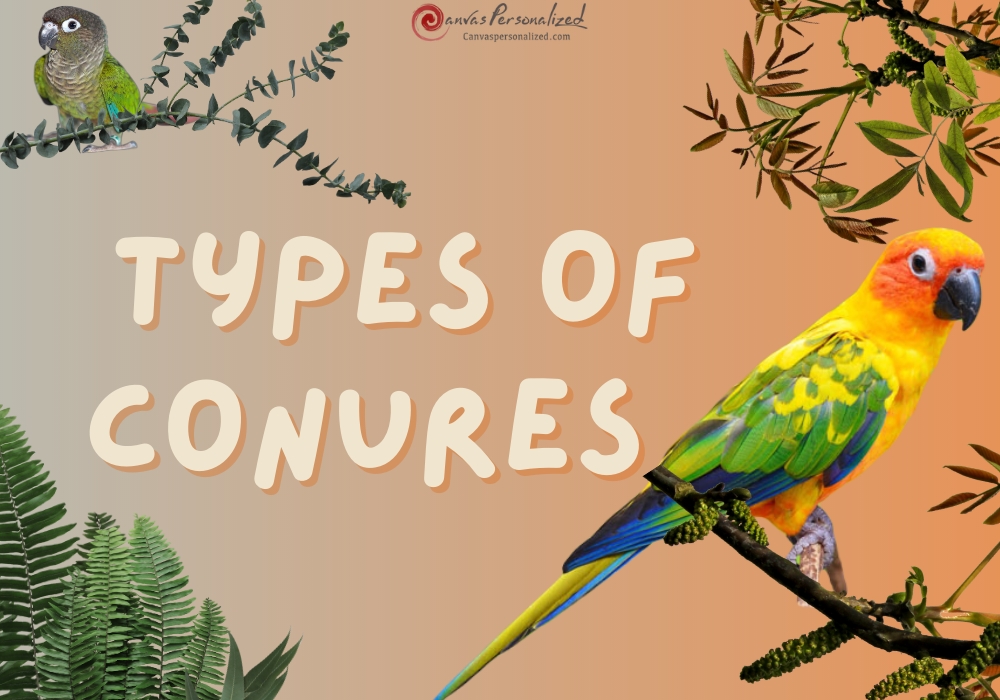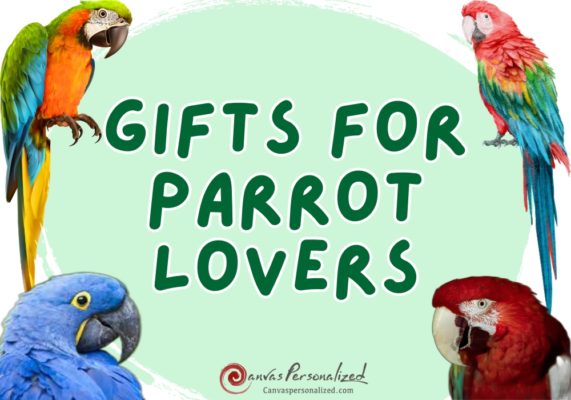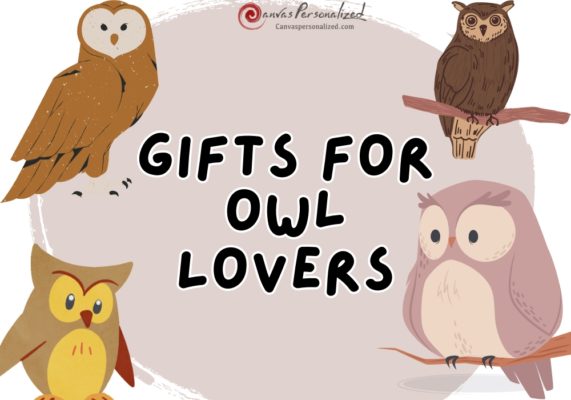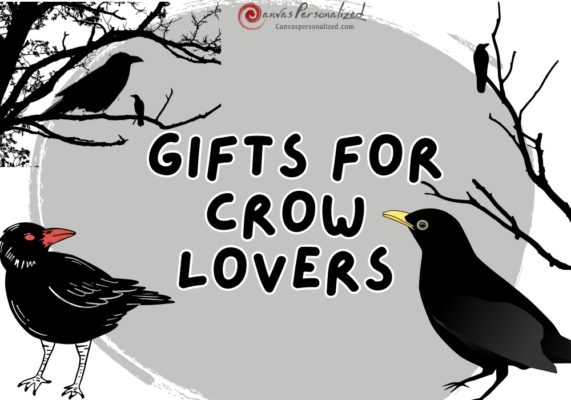People often wonder what kind of bird would make the best pet. Well, Canvas Personalized Blog has the answer for you: the Conure Parrot! In addition to being very clever, conure parrots are also quite lively, making them great pets. These birds are popular because they can be tamed and raised by humans with relative ease.
However, there is more than one kind of Conure Parrot. The conures all have their unique personalities. It can take a lot of work to determine what’s best for you. If you’re looking for a new parrot, you have many options from the Conure species. And which ones are the greatest to keep as pets? This is why we have listed the different types of conures.
Different Types Of Conures To Become Your Awesome Companions
1. Green Cheeked Conure
- Common Name: Green cheeked parakeet, Green cheeked parrot
- Scientific Name: Pyrrhura molinae
- Adult Size: 10 inches, 3 ounces
- Lifespan: 15+ years
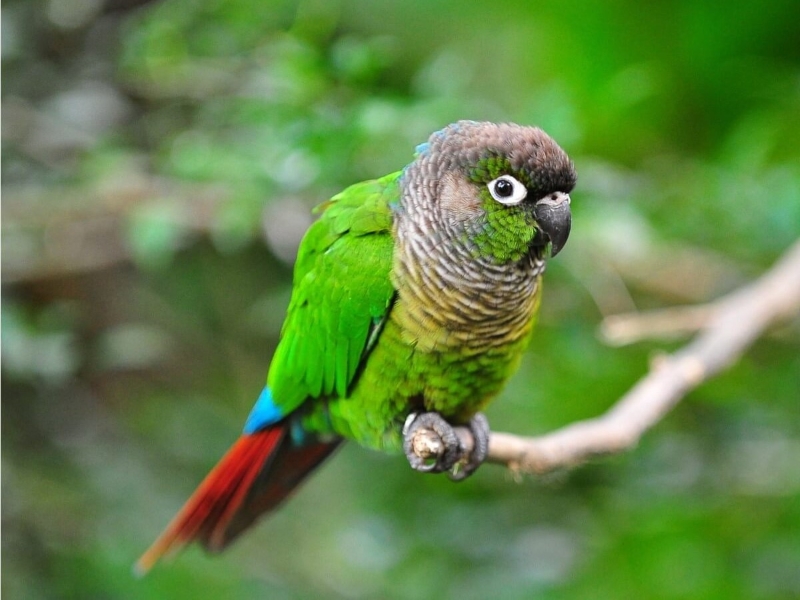
Green cheek conures’ average lifespan is about 15 years, making them one of the shortest-lived parrot species. The Green Cheek is primarily green, with gray chests, maroon tails, and blue primary flying feathers. They have green cheeks and a deeper grey on top of the head. Captive breeding has led to the development of several other color variants of the Green Cheek Conure, including the Cinnamon Cheek, Turquoise Cheek, and Yellow-Sided Green Cheek, as well as the Suncheek and Pineapple Conure
Because they are so lively, they make great pets. Green cheek conures have a lot of energy and fun, often seeking new ways to keep their loved ones entertained. These birds are quieter than other conures. So the Green-Cheeked Conure is a good choice if you don’t want a loud alarm clock or live close to other people.
2. Sun Conure
- Common Name: Sun conure, Sun parakeet
- Scientific Name: Aratinga solstitialis
- Adult Size: 12 inches, 3.5 – 4.3 ounces
- Lifespan: 25-30 years

Absolutely stunning, this bird! The Sun Conure has a mainly brilliant yellow to orange body, with dark orange-red accents around the cheeks and belly. The tips of the wings are iridescent blue, while the rest of the wings are a bright yellow with green splotches. It has a green and blue striped tail.
Sun Conures are very social and are always looking for more people to talk to. Even more, your Sun conure can learn to do tricks. They also make great guards because when someone comes to the door, they scream loudly to let you know.
3. Jenday Conure
- Common Name: Jenday Conure, Yellow-headed Conure, Jandaya Parakeet, Flaming Parakeet
- Scientific Name: Aratinga jandaya
- Adult Size: 12 inches, 5.25 ounces
- Lifespan: Over 30 years
The Sun Conure and the Jenday Conure are similar in appearance and personality. Even though it is similar to the Sun Conure, it has clear bands of color instead of spots of color all over. It has a solid yellow head, a bright green upper body and wings, and an orange-red belly. It has a green and blue striped tail.
These Jenday Conures are friendly, like to play, and want lots of attention. They’ll be very demanding of your time. They also learn quickly, making training a Jenday Conure easy.
4. Patagonian Conure
- Common Name: Burrowing parrot, Patagonian conure
- Scientific Name: Cyanoliseus patagonus
- Adult Size: 17-20 inches, 9.8 ounces
- Lifespan: 20-30 years

The Patagonian Conure, measuring up to 20 inches from beak to tail, is the biggest of the conure species. The body is a dark olive green-brown color with a grey breast, an orange-red belly patch outlined in yellow, and red legs. There is a white band across its neck, and its blue flying feathers are its greatest distinguishing feature.
These birds have a reputation for being fun and lively pet. It will talk to people enough to fool them into thinking it is a person. They are always on the move, engaging in such playful pursuits as dancing, tumbling, jumping, and pranking. Indeed, some bird owners claim that their pets give them kisses on the lips.
5. Golden Conure
- Common Name: Golden conure, Queen of Bavaria conure, golden parakeet, golden parrot, yellow conure
- Scientific Name: Guaruba guarouba, formerly Aratinga guarouba
- Adult Size: 14 inches, 8 ounces
- Lifespan: 20-30 years
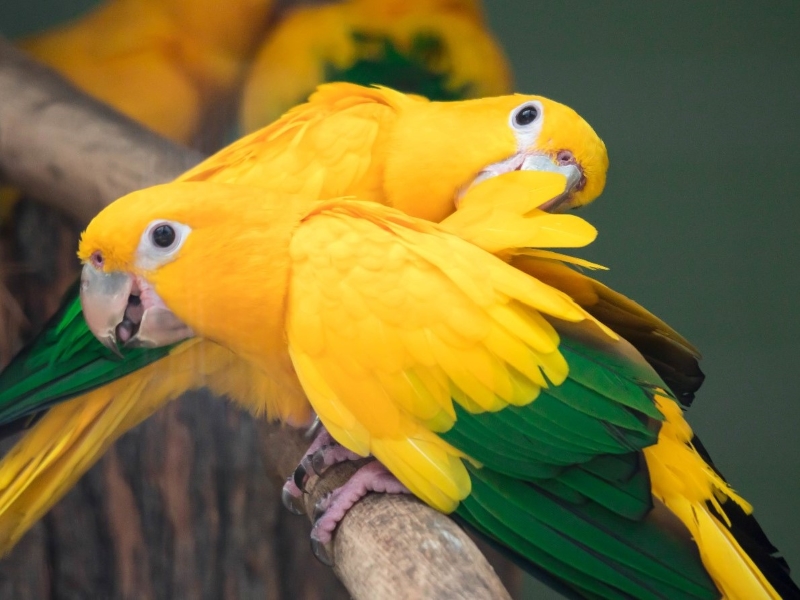
If you want the rarest and most unusual parrot in the world, go no farther than the Queen of Bavaria Conure. These birds, sometimes known as Golden Conures, are stunning in their own right. Bright golden feathers cover it from head to toe, making it easy to see. This conure is easy to identify thanks to its brilliant golden plumage, which extends from its head to its feet.
Of course, their scarcity contributes to their allure. They’re pricey, but you can buy them as pets. Bird owners adore these birds because of their cheerful disposition and friendly personality. They’re great fun, but not everyone can afford an exotic parrot like that.
6. Nanday Conure
- Common Name: Nanday conure, black-hooded parakeet, Nanday parakeet
- Scientific Name: Aratinga Nenday
- Adult Size: 12 inches, 4.9 ounces
- Lifespan: 25-30 years
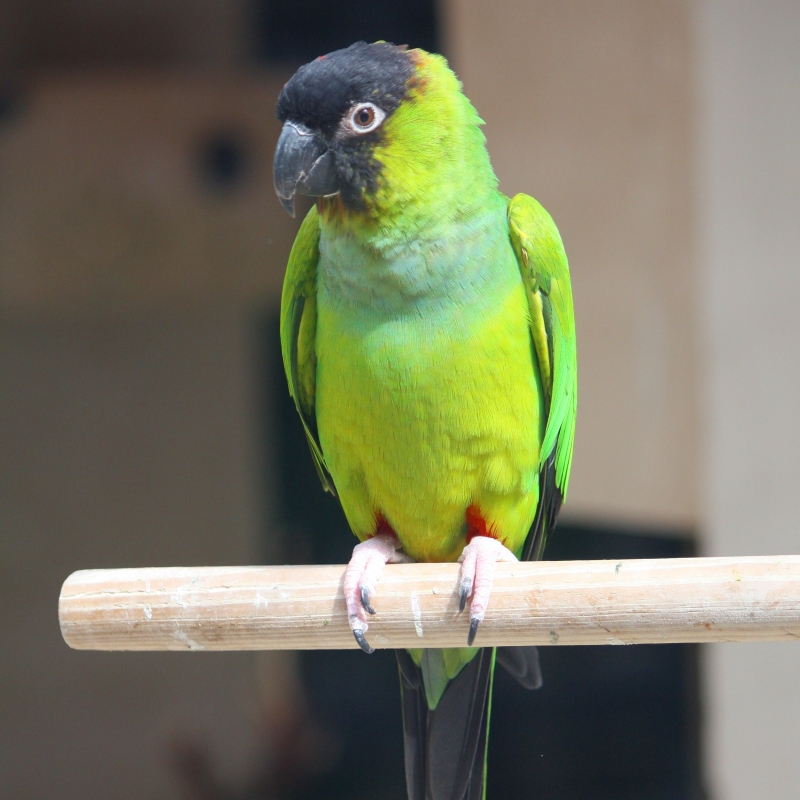
The Nanday Conure’s head is black, and its body and wings are green. And its primary flight and tail feathers are blue. Its legs have a hint of bright red. This parrot isn’t as colorful or bright as some other species of Conures, but it makes up for it with a liberal personality.
They’re always trying to win your love and attention with cute antics and the desire to play. It enjoys being washed, and if trained early, it may do tricks and even learn to communicate with language. It has a powerful beak that may make it unsafe for young children and inexperienced owners, and some owners say it is very noisy among conures. Lack of socialization can also cause it to become exceedingly destructive.
7. Blue-Crowned Conure
- Common Name: Blue crown parakeet, blue crowned conure, or sharp-tailed conure
- Scientific Name: Thectocercus acuticaudatus
- Adult Size: 14.5 inches, 6-8 ounces
- Lifespan: Up to 20 years
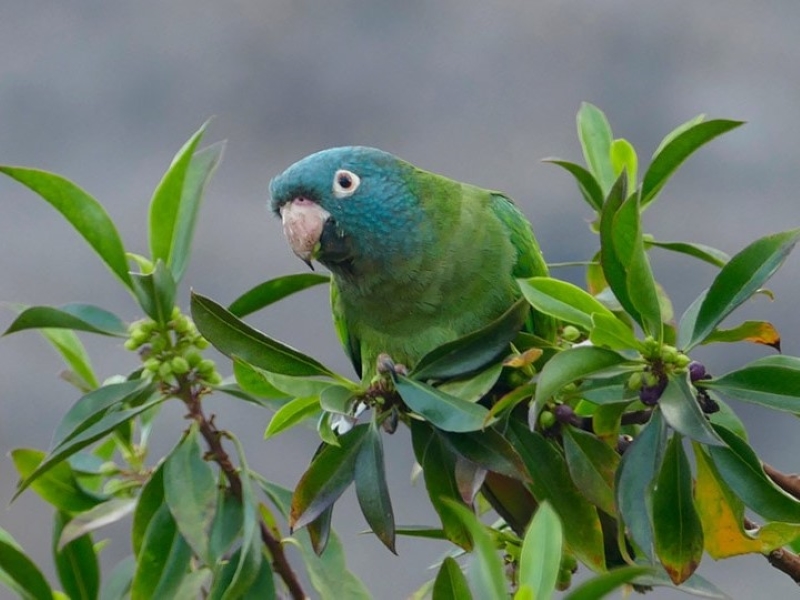
As their name suggests, Blue crown Conures have blue feathers atop their heads. The remainder of its body is a vibrant green color, except the underside of its tail, which can be various shades of red or pink.
This kind of Conure is exceptionally bright and pleasant, making them excellent pets. As a result of their high intelligence and fun nature, Blue-crowned Conures may be easily taught new tricks and words.
8. Maroon Bellied Conure
- Common Name: Maroon-bellied parakeet, reddish-bellied conure
- Scientific Name: Pyrrhura frontalis
- Adult Size: 9-11 inches, 3.2 ounces
- Lifespan: Up to 35 years

The Maroon Belly Conure is a tiny, mostly green parrot with a yellowish-green barring on its breast and flanks. The bird’s belly is maroon, and its primary wing feathers are blue-green. Its tail is green on top and light maroon on the underside. There is a brown spot on its head that covers its ears.
The Maroon Bellied Conures are known for their kind personalities, intelligence, warmth, and playfulness. Even though they have a loud call, they are one of the calmer conures because they don’t screech as much as their bigger relatives. Therefore, they don’t talk well.
9. Dusky-headed Conure
- Common Name: Dusky Conure, Weddell’s Conure, Dusky Headed Conure, Dusky Headed Parakeet
- Scientific Name: Aratinga weddellii
- Adult Size: 11 inches, 3-4 ounces
- Lifespan: Can live 25–50 years, although most live 35–40
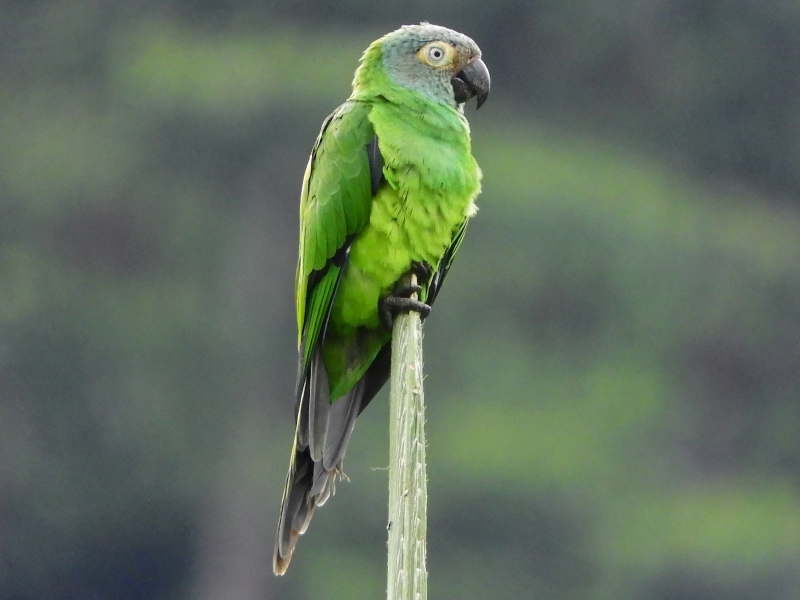
The Dusky Conure’s breast, front, back, and most tail feathers are vivid green, with the under feather being a brighter yellowy green. However, the terminal tail feathers are dark blue. Around the head and neck, the feathers are a ‘dusky’ or greyish tint. The eyes are white or yellow, and the beak and cheeks are a rusty red.
The Dusky-Headed Conure is the most peaceful and tranquil member of the conure family. This bird has a more laid-back personality than other conures. It has a kind demeanor and a gentle, caring disposition. For this reason, they are ideal household pets for households with young children.
>> Further reading: 9 The Most Popular Types Of Lovebirds As Stunning Pets
10. Red Masked Conure
- Common Name: Cherry-headed conure, red-headed conure, red-masked conure, and red-masked parakeet
- Scientific Name: Psittacara erythrogenys
- Adult Size: 13 inches, 5.8-7 ounces
- Lifespan: Up to 25 years
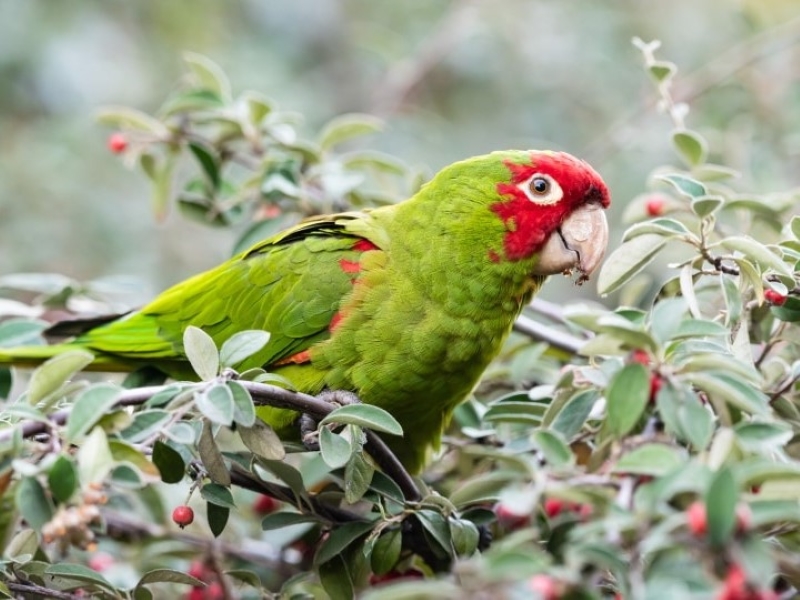
The Red Masked Conure, as its name suggests, has a bright red head, a green body, and white rings around its eyes. Birds that haven’t grown up yet don’t have redheads. After six months, their heads start to turn red.
The Cherry headed conure is one of the most trainable parrots in the world. So its ability to communicate verbally has attracted a lot of attention. They tend to be quite talkative, so it’s only natural that they would start echoing what you say. However, like many parrots, they may get rather noisy at times and may not be suitable for apartment living.
11. Golden-Capped Conure
- Common Name: Golden-capped Conure, Golden-capped Parakeet, Flame-capped Parakeet, Golden-headed Conure
- Scientific Name: Aratinga auricapillus
- Adult Size: 11 – 14 inches, 4.5 – 5.5 ounces
- Lifespan: 20 – 30 years
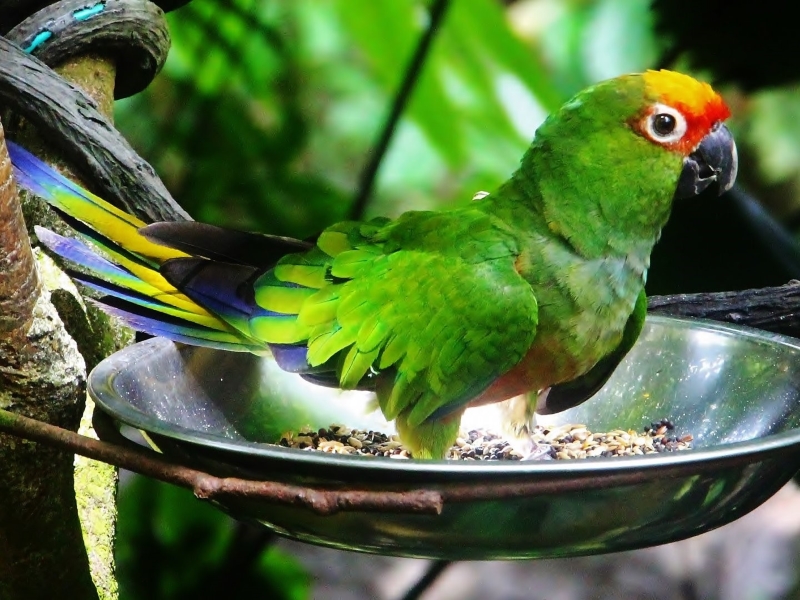
Gold capped conures get their full color once they are about a year old. They have white eye rings, and a red band goes around the white circle and across their forehead. There are different shades of yellow, green, and blue in the tail, and of course, the head is topped with a golden crown.
All they want is to be the center of your attention. When they are confused, happy, or want anything, they will let you know with a scream. Because of this, they’re not suitable for apartments. But they are easy to train and can even learn a few words.
12. Crimson Bellied Conure
- Common Name: Crimson Bellied Conure, Crimson Bellied Parakeet
- Scientific Name: Pyrrhura perlata
- Adult Size: 9 inches, 3.1 ounces
- Lifespan: 20 years
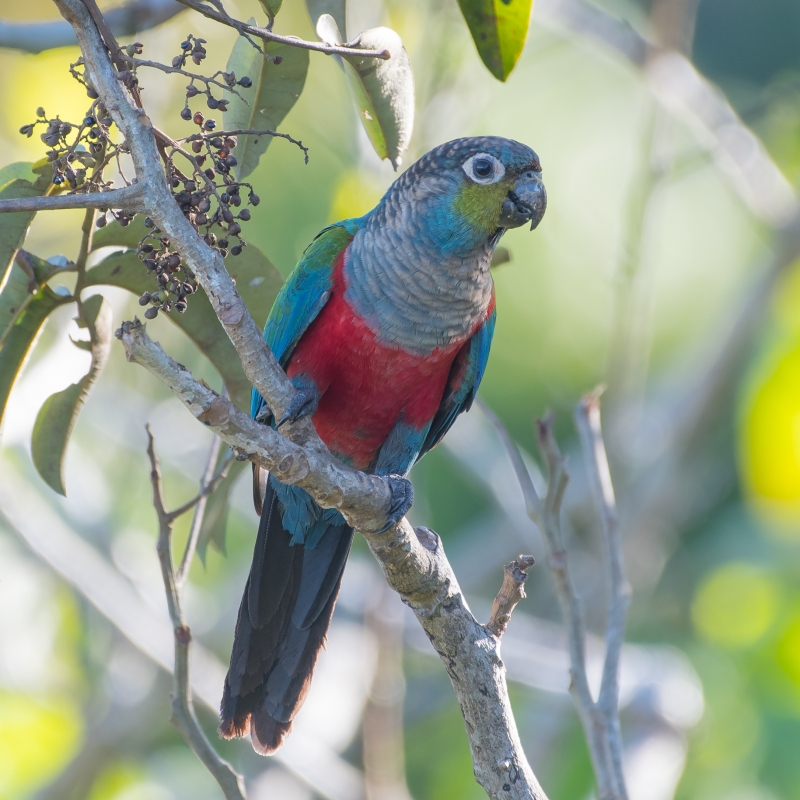
As its name implies, the conure is a brightly colored bird with a red belly. The back, wings, and thighs are predominantly green. Although the undersides of the wings and the upper back sometimes exhibit turquoise color. Green cheeks and a bright blue on the forehead contrast with the white and grey of the head, neck, and chest.
The energetic and sociable Crimson Bellied Conure is one of the most popular conures as pets. It’s rare to find a bird with such a close attachment to its owner that it would cuddle up to them. It has a gentle, melodious cry and is known to whistle tunes or imitate household noises. But if you ignore it, it will get much noisier, and they may even start tearing apart everything in their cage.
13. Brown Throated Conure
- Common Name: The prikichi, St. Thomas conure or The Brown-throated conure
- Scientific Name: Eupsittula pertinax
- Adult Size: 10 inches, 3.1 ounces
- Lifespan: Up to 25 years
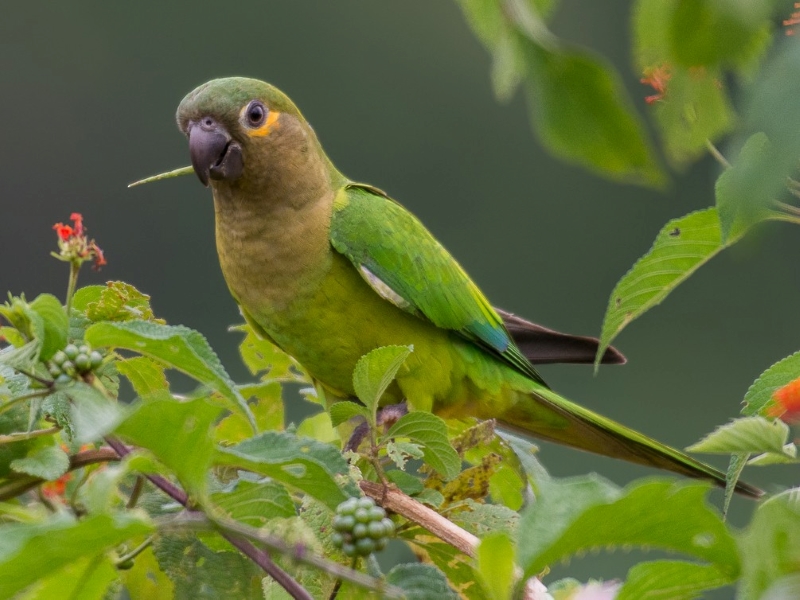
The Brown-Throated Conure, one of the rarest conures in the world of parrots, makes a wonderful pet. This bird is a plain yet endearing parrot because of its muted coloring, earthy tones, and lack of intricate patterning. The upper part of the body has a vibrant green color, while the lower leg, including the breast and abdomen, is more yellowish and paler. Their name comes from the brownish-green coloring of their cheeks and neck.
These feisty little birds are full of life and activity. So you can always expect them to learn new tricks and makeshift toys. They are easy to care for, making them an excellent choice for first-time bird owners or anybody seeking a companionable and affectionate parrot.
Conure Pet Requirements for Care and Diet
Food for Conures
- Your conure’s diet should consist primarily of pellets designed specifically for conures, with the remaining 30 to 40 percent consisting of fresh produce and fortified seeds.
- Drinking water that is consistently pure and fresh.
- Avocados, fruit seeds, chocolate, coffee, and alcohol are all poisonous to birds and should be kept away from them, as should treats high in salt, sugar, and fat.
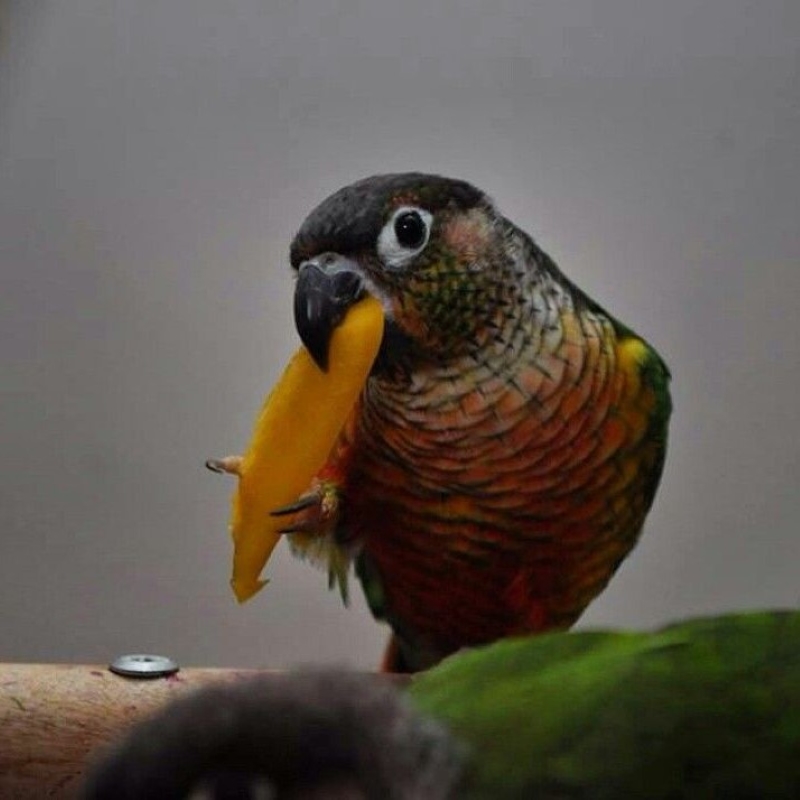
Remember these things when you feed your conure:
- Remove any fruits and vegetables sitting out for more than 10 to 12 hours.
- Treats shouldn’t make up more than 10% of birds’ food.
- If more than one conure lives in the same habitat, give it more than one feeding station to stop them from fighting over food.
- Although birds are gregarious and want to eat when their flock mates do, it is essential to remember that the bacteria found in human mouths can cause disease in birds. Therefore it is best to avoid sharing food or drinks with them.
- Conures don’t need grit to grind up their food because they take the hulls off seeds before eating them.
How to care
- Bird owners should spend time with their pets every day. Their daily routine should include time spent outside, allowing them to socialize and exercise.
- Conures need constant supervision outside their natural environment to prevent them from hurting themselves or getting into mischief.
- Birds must be regularly groomed, including having their nails trimmed every few weeks to months. Only a trained person should trim the nails to keep the bird from getting hurt.
- Most birds only need to have their beaks trimmed regularly unless they have a health problem (like a liver disease).
- Correctly clipping the five outermost flight feathers can help avoid harm or escape. Consult a veterinarian to determine what’s best for your bird!
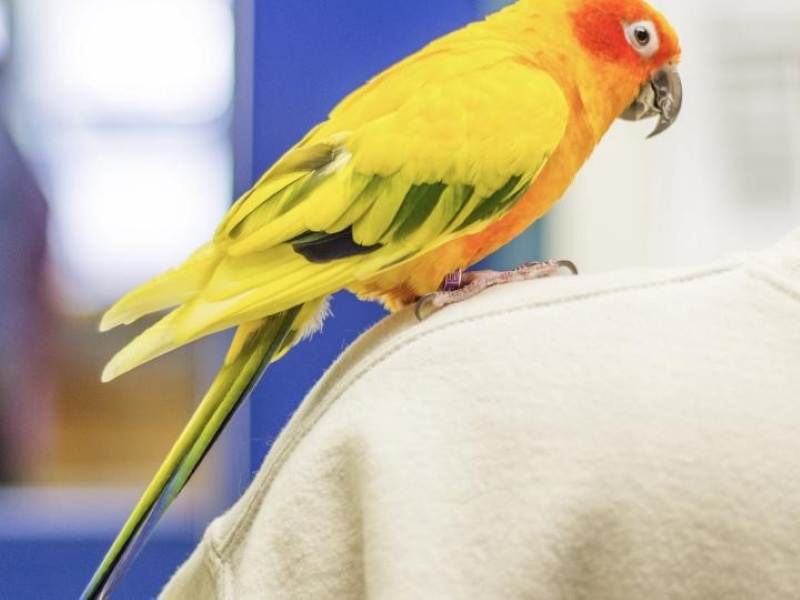
Are Conures Suitable For You?
On the pet market, you may find various types of conures. They may be found in different sizes, hues, and even in their singing abilities. Some are pretty shy and quiet. Others, however, are very loud, talkative, and active birds, which is something to consider when choosing a conure that fits your lifestyle.
Hand-raised conures are ideal pet parrots because of their outgoing personalities and intelligence. However, their need for human connection and care might be relatively high. If you meet their demand, they can keep quiet and stop trying to get people’s attention. If you don’t have time for these cute birds, getting a pet bird that doesn’t need as much care would be better.
How To Get a Conure Pet?
Conures can be purchased from a variety of sources, including general pet stores, avian specialist shops, and private bird breeders. In addition, several avian adoption centers often have them available for adoption. When properly socialized, a conure raised in a home environment may be wonderful companion animal.
The price of a conure as a pet can range from free to several hundred dollars, depending on the conure’s age, breed, and whether or not it was hand-raised. Some rare species of conures might cost considerably more than the normal price range of $200-$800. The adoption cost for a pet from a rescue or shelter can be as little as $50 and as much as $200. It’s important to remember that adoption costs might range widely based on factors like the institution and the geographic region.
| Name | Location | Website | Number |
| S&S Aviary | Florida | http://www.ssaviary.com | (305) 431-0181 |
| Royal Bird Company | Illinois | https://www.royalbirdcompany.com | (815) 568-2669 |
| The Feather Tree | California | http://www.feathertree.com | (805) 649-5551 |
| Birds By Joe | New York | http://www.birdsbyjoe.com | (631) 957-1100 |
>> Another related post that you may be interested in:
- 15 Popular Types Of Finches: A Complete List With Photos
- 10 Types Of Amazon Parrots To Keep As Awesome Pets
There’s a lot of variety among the types of conures. Looking for a talkative and affectionate bird with colorful plumage? Or a bird with a more calm personality and less bright colors? You’ll be able to find the perfect Conure for you! Canvas Personalized Blog hopes you now have a better idea of which Conures to look into before bringing one into your home.


